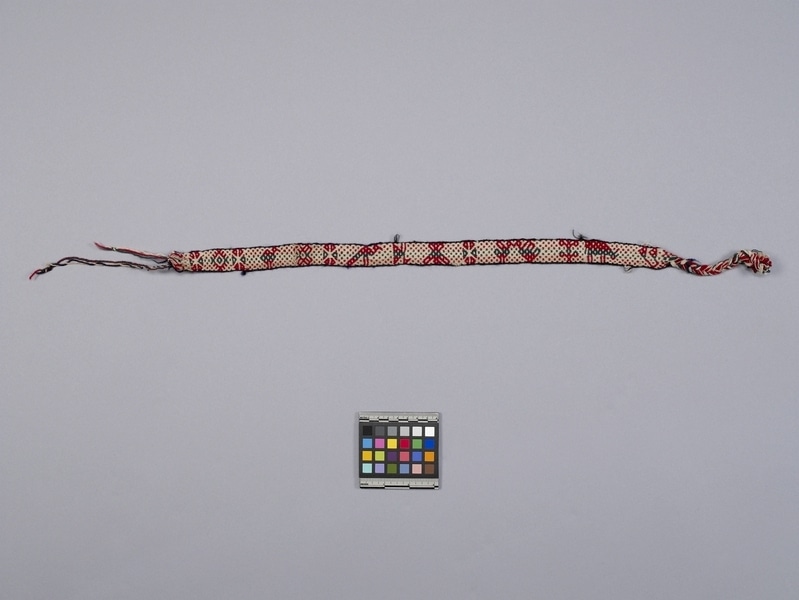Belt Item Number: Sf907 from the MOA: University of British Columbia


Description
Belt formed by a narrow woven band with white figurative patterns in off-white worked against a background of dark red and green. Images of birds, a llama (?) as well as abstract motifs like circles, diamonds and crosses are arranged along its length. The other face of the fabric has figure and ground colours inverted. One end is finished with a braid, and the opposite end consists of loose wool strands.-
History Of Use
Warp-faced fabrics with three or four selvedges are woven by women but the fabrics are used by both sexes. The techniques, structures and some of the motifs have pre-Conquest antecedents. This type of textile conveys the most information about an individual's ethnicity, sex, age, status and particular history. Young girls begin weaving narrow bands at about age 5. They weave progressively wider pieces until they are able to handle major pieces in their mid to late teens. The bands have miscellaneous uses on Taquile as belts and straps as well as vehicles for learning the designs. They are also sold to tourists.
Specific Techniques
Most yarns are wool, handspun z and plied 2-s. Red yarns appear to be commercial synthetic yarns that have been re-twisted. The weave structure is a complementary-warp weave with 3-span floats aligned in alternate fours with an irregular warping order (abbabababaababab). The warps in the terminal area are grouped and braided.
Cultural Context
learner's weaving
Iconographic Meaning
The range of motifs refers to local geography and landmarks, ecology, fecundity as well as luck. The six part circle refers to the division of land into six sections on Taquile and the rotation of crops and fallow periods.
Item History
- Made by Andrea Huatta Cruz (Maker) in Taquile, Puno, Peru during May 1984
- Collected by Elizabeth L. Johnson during 1984
- Owned by Elizabeth L. Johnson before June 13, 1984
- Received from Elizabeth L. Johnson (Seller) and Museum of Anthropology Shop Volunteers (Funding source) on June 13, 1984
What
- Name
- Belt
- Identification Number
- Sf907
- Type of Item
- belt
- Material
- wool fibre, acrylic fibre ? and dye
- Manufacturing Technique
- woven, spun, plied, retwisted and braided
- Overall
- height 2.3 cm, width 62.0 cm
Who
- Culture
- Quechua
- Creator
- Andrea Huatta Cruz (Maker)
- Field Collector
- Elizabeth L. Johnson
- Previous Owner
- Elizabeth L. Johnson
- Received from
- Elizabeth L. Johnson (Seller) and Museum of Anthropology Shop Volunteers (Funding source)
Where
- Holding Institution
- MOA: University of British Columbia
- Made in
- Taquile, Puno, Peru
When
- Creation Date
- during May 1984
- Collection Date
- during 1984
- Ownership Date
- before June 13, 1984
- Acquisition Date
- on June 13, 1984
Other
- Item Classes
- textiles
- Condition
- fair
- Accession Number
- 0992/0003